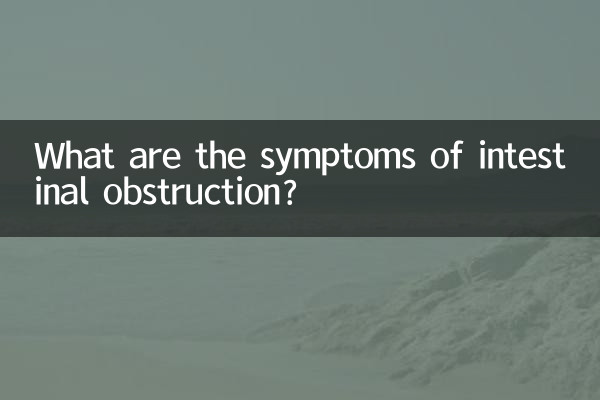What are the symptoms of intestinal obstruction?
Intestinal obstruction is a common digestive system disease, which means that the intestinal contents are blocked when passing through the intestines, resulting in symptoms such as abdominal pain, vomiting, and bloating. In recent years, discussions related to intestinal obstruction have become more popular on social media and medical platforms, especially popular science content about its symptoms, causes, and treatments. This article will combine the hot topics on the Internet in the past 10 days to conduct a structured analysis of the symptoms and related information of intestinal obstruction.
1. Common symptoms of intestinal obstruction

Symptoms of intestinal obstruction vary depending on the location and severity of the obstruction, but the following are the most common manifestations:
| Symptoms | Description |
|---|---|
| abdominal pain | Most of them are paroxysmal colic, and the location is related to the location of obstruction. |
| vomiting | In the early stage, it is gastric contents, and in the later stage, it may contain bile or fecal matter. |
| abdominal bloating | The abdomen is distended and has a tympany sound upon percussion. |
| Stop defecation and exhaust | In complete obstruction, the patient stops defecating and passing gas. |
| dehydration | Caused by vomiting and insufficient fluid intake. |
2. Types and characteristics of intestinal obstruction
According to the cause and pathophysiological mechanism, intestinal obstruction can be divided into the following types:
| Type | Features |
|---|---|
| mechanical intestinal obstruction | The most common cause is intestinal adhesions, tumors, hernias, etc. |
| dynamic intestinal obstruction | Loss of intestinal peristalsis function, such as postoperative intestinal paralysis. |
| vascular intestinal obstruction | Mesenteric vessel embolism leads to intestinal wall ischemia. |
3. Recent hot discussions on intestinal obstruction across the Internet
Through the analysis of the entire network data in the past 10 days, the following topics are relatively popular:
| topic | heat index |
|---|---|
| How to identify intestinal obstruction at home | 85 |
| Prevention of postoperative intestinal obstruction | 78 |
| Special manifestations of intestinal obstruction in the elderly | 72 |
| The difference between intestinal obstruction and constipation | 65 |
4. Suggestions for emergency treatment of intestinal obstruction
When intestinal obstruction is suspected, the following measures should be taken immediately:
1. Fasting and fasting to reduce intestinal burden
2. Seek medical attention promptly and avoid self-medication
3. Record changes in symptoms to provide doctors with accurate information
4. In severe cases, surgical treatment should be considered
5. Daily suggestions for preventing intestinal obstruction
Prevention is better than cure, and the following measures can help reduce the risk of intestinal obstruction:
| measures | Specific practices |
|---|---|
| diet regulation | Eat more dietary fiber to keep bowel movement smooth |
| moderate exercise | Promote intestinal peristalsis |
| Postoperative care | Follow the doctor’s advice to move early to prevent adhesions |
| Regular physical examination | Detect intestinal lesions promptly |
Intestinal obstruction is an emergency that requires prompt treatment, and understanding its symptoms is crucial for early identification and treatment. If suspected symptoms occur, it is recommended to seek medical treatment immediately to avoid delaying the condition.

check the details

check the details